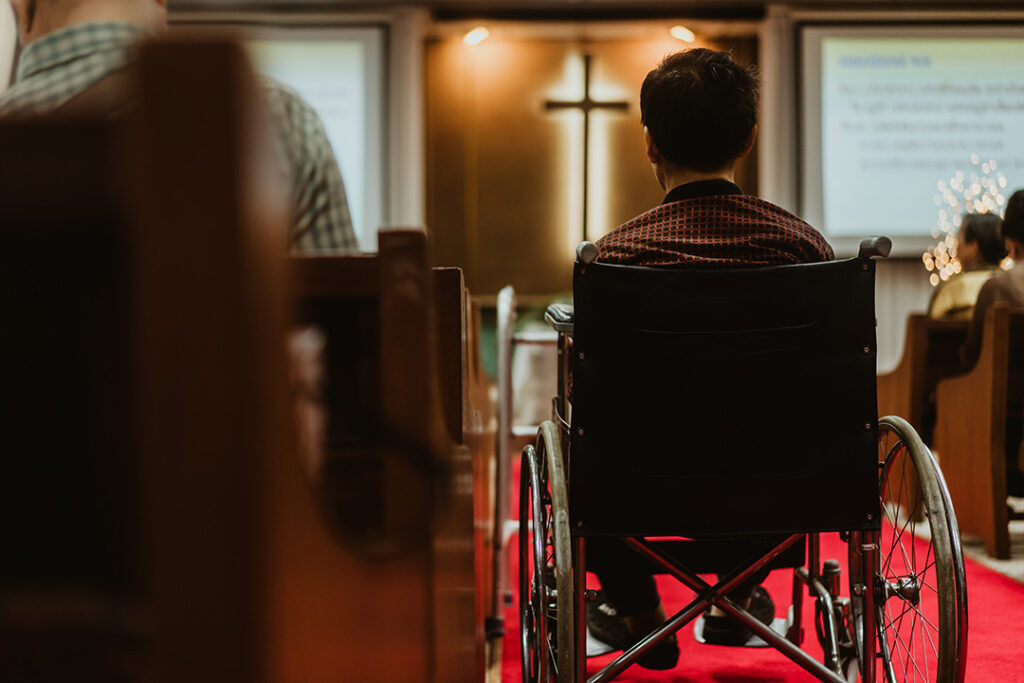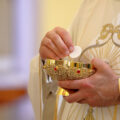Making room for people with disabilities in Christian churches
Making room for people with disabilities in Christian churches
People with disabilities are as religious as the general population. So what can churches do to foster inclusion?
This weekly comment was written by Clémence Sauty and reflects her personal analyses and opinions, rather than those of EARS.
On the occasion of All Saints’ Day[1] in November 2022, a French Christian magazine released a special edition that addresses the sanctity of people with disabilities.[2]
Editor-in-chief Cyril Douillet explains this choice of topic: “There certainly already are people with disabilities among the saints. So why not canonise people who are known to have a handicap? Fragility is a privileged journey towards sanctity.”[3] In other words, Douillet demands that churches pay attention to faithful people with disabilities, and officially recognise saints among them.[4]
Christian attitudes towards people with disability are ambivalent
Douillet echoes the Christian tradition, where disability is both considered a fragility and an extraordinary way to connect with God. These beliefs can support a greater inclusion of people with disabilities in religious environments as well as in societies at large. Welcoming people with all variations of capabilities is even part of the Catholic identity.
Yet, such beliefs can also perpetuate the objectification of people with disabilities. Idealising ‘disability’, one risks overlooking the people who actually experience it. Paradoxically, the Christian tradition can also dehumanise people with disabilities.
In practice, Christian churches both empower and harm people with disabilities. Very few people with disabilities are in a position to lead, and to speak from their experience.[5] [6] So, for the time being, almost all texts and policies about disability are designed from an ‘us’ point of view, about a ‘them’ that is somehow different.
People with disabilities are as religious as the general population
People with disabilities are neither more nor less religious than those without the equivalent disabilities in the general population. There is however little data on the topic in Europe.
In the Netherlands, a 2020 study noted that the majority of people who went to a denominational healthcare institution expected faith to be part of their treatment. More surprisingly, it suggested that more than half of the patients within secular mental health care longed for spiritual support through their treatment.[7] This renewed the debate over the use of spirituality and religion to soothe patients with mental illness.
The vast majority of studies aiming at assessing the religiosity of people with disabilities were conducted in the US. American researchers mainly argue that religion benefits people, including people with variant abilities.[8]
As it turns out, it seems that people with disabilities are more likely to report praying several times a day, than those without the equivalent disabilities in the general population. On the contrary, they are significantly less likely to attend religious services. They are also considerably more prone to experience a greater faith-based disappointment during their life.[9]
How could Christian communities effectively include people with disabilities?
Even if people with disabilities are on average as religious as anyone else, some of their most significant life experiences are specific. This, in turn, shapes how they experience religion and spirituality. How can Christians make their theologies and communities relevant and inclusive to people with such backgrounds?
I would argue that physical accessibility is only one of the many initiatives that can be taken towards effective inclusion. Here are some personal suggestions:
- Taking the experiences of people with disabilities into account
Checking the narratives that are shared in religious spaces is a kind of ‘giant leap for mankind’. Simple questions can have a tremendous impact: “Does this theology idealise or demonise disability? Does it imply that some people are ‘less than’? Do the myths and beliefs we share reflect the diversity of human bodies, minds, and experiences? Did people with disabilities participate in creating these narratives? What tools have we built together for everyone to be able to participate?”
- Letting people participate on their own terms
Paying attention to making space for people with disabilities to tell their stories and centre their own questions and thoughts is essential. The only purpose to making churches inclusive is precisely -and exclusively- that people can safely participate in church. Additional goals (like increasing worship attendance, or proving an unrelated theological point, or advertising one’s community) are irrelevant. For example, asking people to tell stories of trauma in front of a crowd in order to create a collective emotion is irresponsible and counterproductive.
On the contrary, Christians can simply ask congregants if and what they would like to contribute to the community. In doing so, they would make sure not to assume what anyone can and cannot do. Besides, promoting active participation of everyone makes people’s dignity and agency visible; and that is a way of teaching respect and inclusion.
- Learning to identify with the limitedness of the human condition
Checking one’s narratives and listening to faithful people with disabilities could greatly enrich Christian theologies and communities. These new perspectives might even cause believers to learn about new ways to relate to their human condition and to God.
Being aware of the power of words to harm or emancipate indeed makes a difference. Constantly praying for health excludes the many people who have chronic illnesses and disabilities and will never achieve the goal that able-bodied people set for themselves. Instead, praying for physical and mental unbending, for rest, softness, and the blossoming of the soul can convey the same message without the unnecessary violence.
The byproducts of inclusion
Inclusion implies making efforts towards those who have been kept away from the church. Rather than expecting the marginalised to earn their way into a community, one works with them to make the community more accessible.
Consequently, inclusion comes from the privileged. Does this mean that those who were there ‘first’ are aggrieved in the process? Inclusion is its own purpose. Still, I believe that traditional community members can gain something for themselves: the opportunity to renew their understanding of humanity and dignity.
This weekly comment was written by Clémence Sauty and reflects her personal analyses and opinions, rather than those of EARS.
Interested in similar topics? Go to our Dashboard and receive free updates.
[1] All Saints’ Day is a Christian solemnity celebrated in honour of all the saints of the church. See here: All Saints’ Day – Wikipedia
[2] Ombres & Lumière – Le magazine chrétien du handicap et de la fragilité
[3] Pour la canonisation de personnes handicapées !
[4] In several Christian denominations, canonisation is the process through which a deceased person is officially recognised as a saint. See here: Canonization – Wikipedia
[5] Catéchèse et théologies du handicap
[6] Christian denominations however strive to evolve.
[7] Psychiatrisch patiënten willen méér ruimte voor spiritualiteit in hun behandeling
[8] In Their Own Words: The Place of Faith in the Lives of Young People With Autism and Intellectual Disability
[9] Spirituality among People with Disabilities: A Nationally Representative Study of Spiritual and Religious Profiles | Health & Social Work | Oxford Academic






